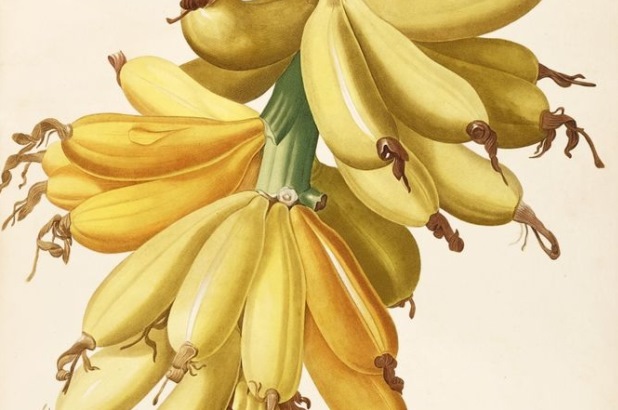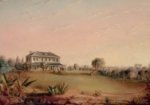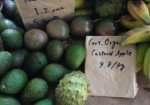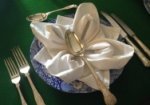By the 1830s colonial gardens in New South Wales featured a wealth of exotic plants that in Britain were only found in costly hothouses, including that staple of the fruit bowl, the sweet banana and its cousin the plantain.
Remember Godfrey Mundy’s dinner at Tarmons?
“A delicate wing of the wonga wonga pigeon with bread sauce, and a dessert of plantains and loquots, guavas and mandarine oranges, pomegranates and cherimoyas, landed my imagination at length fairly at the Antipodes.” Godfrey Mundy, ‘Our Antipodes’, entry for June 29, 1846.
For him the array of fresh, exotic fruit readily at hand on colonial tables was a reminder that he certainly wasn’t in Kansas England anymore. These plants were considered both as decorative exotics, as prestigious possessions – the phrase ‘trophy plants’ is certainly applicable – and for their produce, be it their timber, flowers, or fruit. The Botanical Garden (now the Royal Botanic Gardens, Sydney) was at the forefront of trialling these plants:
“BOTANY. A considerable, degree of improvement has been of late visible in the Government Botanical Garden, of which Mr Fraser is botanist… Among the rare and tropical productions here which appear to succeed best, may be classed the banana, mango, mangosteen, plantain, orange, prickly pear, Indian fig, aloe, cocoa, cashew nut, cork tree…” The Australian 12 October 1827
Along with enthusiastic gardeners, ‘acclimatisation societies’, of which the Macarthur sons James and William were members (along with the French Légion d’honneur, in 1861 William was made an honorary member of the Société Impériale Zoologique d’Acclimatation) actively imported and trialed plant and animal species. These weren’t always successful introductions – consider the prickly pear, which was first thought of as a useful impenetrable fencing material before it became a national scourge.
Others like the banana however, which was among the plants brought from Rio de Janeiro on the First Fleet in 1788, have always been a valued crop. In colonial gardens they were both highly decorative and provided a treat for the table. This 1845 view of the garden at Barham on Woolloomooloo Hill – home to Governor Bourke’s second daughter, Anne Maria, and her husband Edward Deas Thompson – includes a variety of sub-tropical exotics, including bamboo, prickly pear and 2 clumps of bananas.
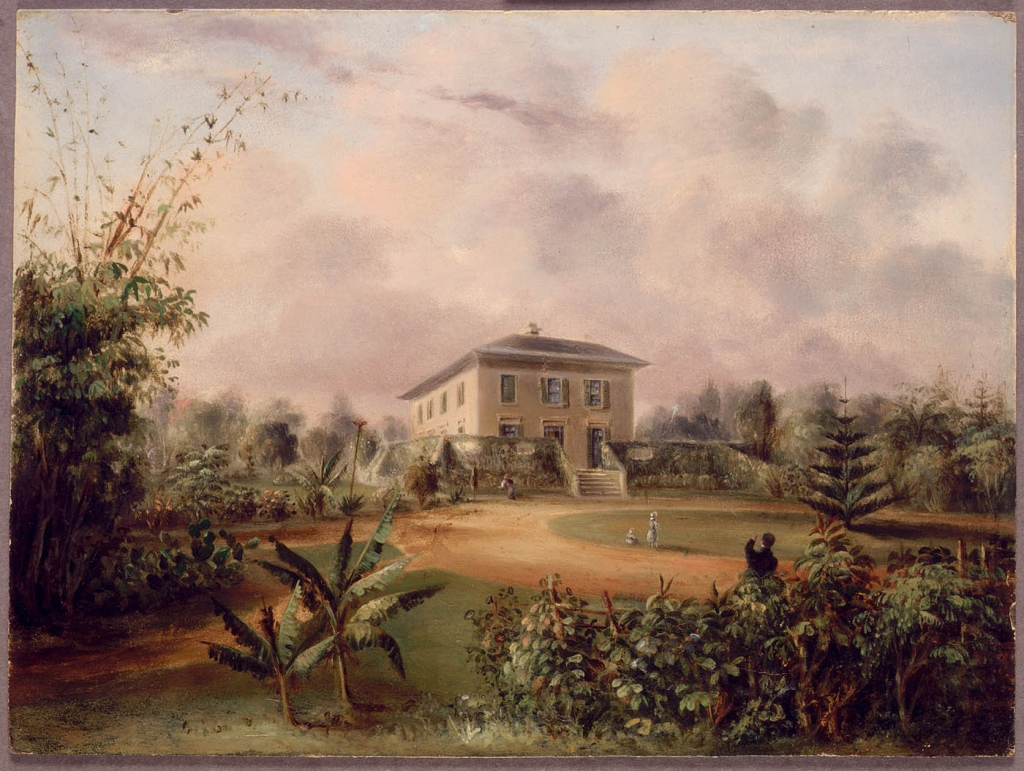
George Peacock. “[Barham] Residence of The Honble E.D. Thomson Sydney N.S.W”, 1845. State Library of New South Wales, Dixon Gallery DG355
![Rosalie Thorn, "Vaucluse 26 11 [18]69". Vaucluse House collection, V85/9](../../app/uploads/sites/2/2015/12/618x418xRosalie-Thorn_Vaucluse-26-11-1869_Vaucluse-House-collection-V85_9-1024x693.jpg.pagespeed.ic.4NWERkof7a.jpg)
Rosalie Thorn, “Vaucluse 26 11 [18]69”. Vaucluse House collection, V85/9
![View of the service wing with banana stand at Vaucluse House [detail]. Photo © James Horan for Sydney Living Museums](../../app/uploads/sites/2/2015/12/View-of-the-service-wing-with-banana-stand-at-Vaucluse-House_detail_Photo-%c2%a9-James-Horan-for-Sydney-Living-Musuems.jpg)
View of the service wing with banana stand at Vaucluse House [detail]. Photo © James Horan for Sydney Living Museums
So many bananas!
But exactly what sort of banana was being grown? Today the Cavendish banana – Musa cavendishii – dominates. This was a form first classified by Joseph Paxton (yes, he of the prodigious glasshouses) in 1837. Paxton was then working for William Cavendish, 6th Duke of Devonshire at his estate Chatsworth (frequently a stand-in for ‘Pemberley’). Even before then it was a well traveled plant:
MUSA CAVENDISHII: the Cavendish plantain – This highly interesting and most valuable plant is a native of China; it was sent from the Mauritius in 1829 by the late Charles Telfair, Esq., to his friend the late Mr. Barclay of Burryhill. Mr. Cameron, Curator of the Birmingham Botanic Gardens, has kindly furnished us with the following particulars respecting its history:—
“The only plants of the Chinese Musa, that I ever heard of, were two imported ones received under that name at Burryhill in 1829. They were sent from the Mauritius by the late Charles Telfair, Esq., who stated in his letter, that he had obtained the species two or three years previously from China, that he had been at much pains in collecting together all the species and varieties of Musa he could obtain, and that he considered the one sent to be the most valuable, as it fruited profusely, and, only growing three feet high, would render it a great acquisition to the stoves of this country.”
Messrs. Young, of Epsom, purchased both plants at Mr. Barclay’s sale, one for the Duke of Devonshire, and the other to go to the continent. [1]
Another letter from Mauritius highlighted the plant’s fruiting capacity – and its taste:
With respect to the fruit, which is its most valuable quality, an extract from a letter addressed to our friend, Mr Cooper of Wentworth, dated March 1st, 1835, from Mr Newman, superintendent of the Royal Gardens at Mauritius, will at once explain. “Returning again to my experimental garden, I have a dwarf sort of Banana which has fruit of an exquisite flavour, and I think would do well in England with very little care in the hothouse. I have gathered 240 fruit from a single raceme, and in less than a year after planting : if you like to have a few plants, I will with pleasure send them ; I feel confidant that ere long this and several other varieties of Musa will be cultivated for the tables of the great in England.” [1]
Available from William Macarthur’s Camden Park nursery in 1850 and Thomas Shepherd’s Darling Nursery in 1851, this is most probably the species that we see in the Vaucluse and Elizabeth Farm views. In my own garden I have Musa acuminata, which has leaves decoratively patterned with purple.
Musa paradisiaca [L] and Musa sapientum from Paxtons ‘Magazine of Botany and Register of Flowering Plants’, Vol. 3, 1837. Image: Missouri Botanical Gardens
The “banana of paradise”
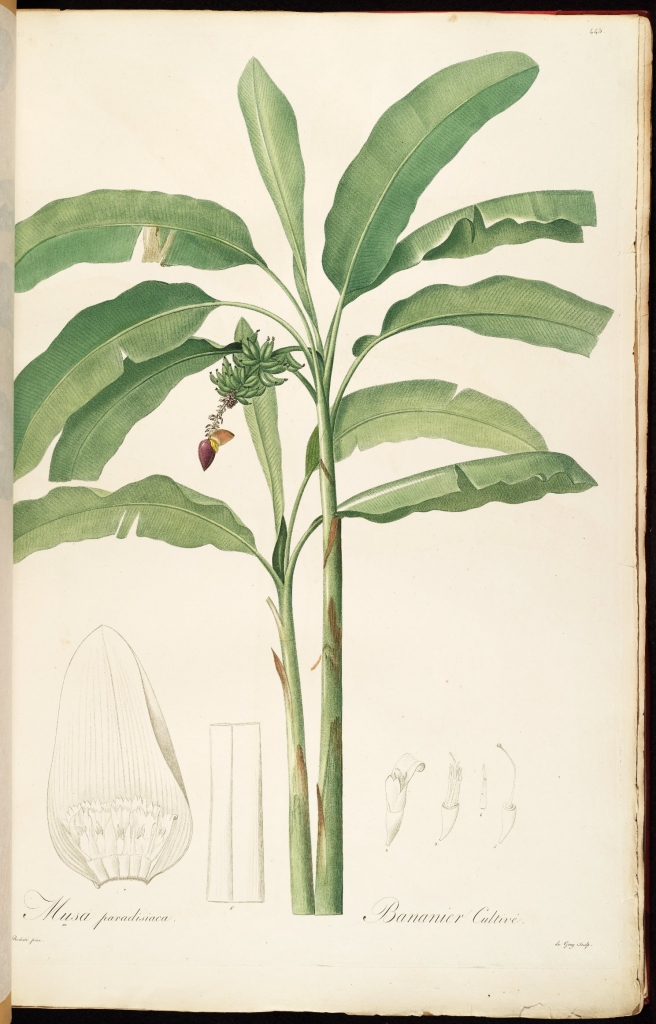
P. J. Redoute, “Musa paradisiaca L[innaeus].”, Les liliacees, Vol. 8. 1805- 1816. Missouri Botanic garden.
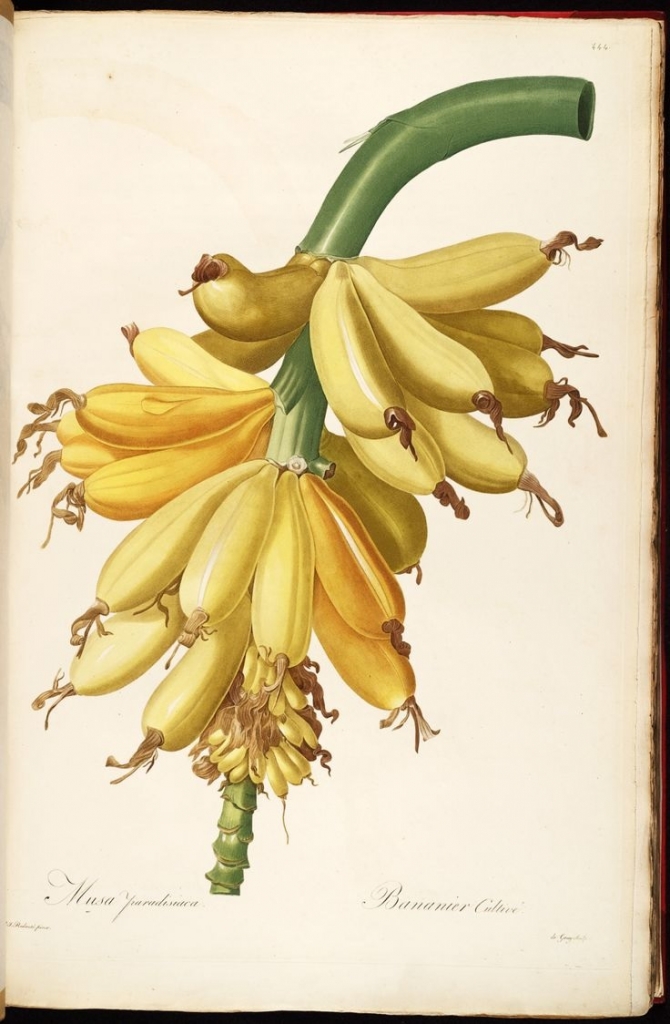
Musa paradisiaca. P. J. Redoute, Les liliacees Vol.8, 1805-1816. Image: Missouri Botanical Garden
The scientific name for the plantain in the colony – Musa paradisiaca – was given by the 18th century Swedish naturalist Carl Von Linnaeus, hence the ‘L’ in the captions to Redoute’s plates. Musa sapientum (the Latundan banana, Musa acuminata × M. balbisiana ), the ‘food of the wise’, was reserved for sweet dessert bananas. The plantain, quite simply, looks like a rather large and quite solid banana, often missing the distinct curve of smaller bananas. It’s sold when a vivid, bright green (Redoute shows it fully ripe in his illustration), and is used not as an eating or ‘dessert’ banana, but for cooking. Also unlike the sweeter Cavendish, they are often used when the skins are green. These are a hefty pair I picked up at an Indian grocery shop. They’re at least twice the size of a sugar banana, and quite straight in comparison to a curvy Cavendish:

Plantain bananas. Photo © Scott Hill Sydney Living Museums
Next we’ll look at a 19th century recipe for using plantains – ‘curried bananas’!
Second helpings
[1] Joseph Paxton, Paxton’s Magazine of Botany, and Register of Flowering Plants, Volume 3. W.S. Orr & Co., Paternoster Row London, 1837.
You may have seen a banana with truly prodigious leaves, and bold scarlet ribs. This is Ensete ventricosum, the Abyssinian or Ethiopian banana. Its fruit is inedible, however its root and parts of the stem are a valuable food crop in eastern Africa. If you can grow this stunning plant leave plenty of room as the leaves can be over 3 meters in length! Its most famous appearance is as the flamboyant centerpiece of the dining room ceiling at George IV’s Brighton Pavilion.
